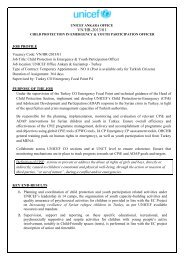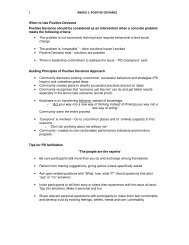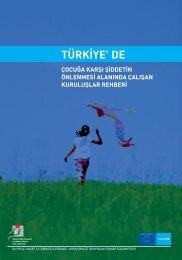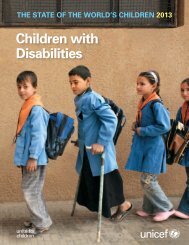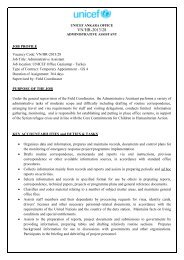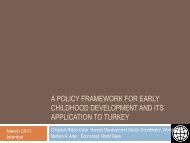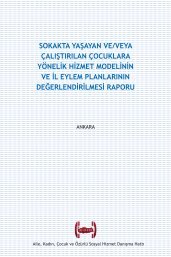REFERANSLARBölüm 1 Giriş1 World Health Organization, ‘Community-basedRehabilitation Guidelines’, WHO, Geneva,2010, , accessed31 January 2013.2 Groce, Nora Ellen, ‘Adolescents and Youthwith Disabilities: Issues and challenges’, AsiaPacific Disability Rehabilitation Journal, vol.15, no. 2, July 2004, pp. 13–32.3 Committee on the Rights of the Child,Convention on the Rights of the Child GeneralComment No. 9 (2006): The rights of childrenwith disabilities, CRC/C/GC/9, Geneva,27 February 2007, pp. 2, 9; Jones, Lisa, etal., ‘Prevalence and Risk of Violence againstChildren with Disabilities: A systematic reviewand meta-analysis of observational studies’,The Lancet, vol. 380,no. 9845, 8 September 2012, pp. 899–907;World Health Organization and the WorldBank, World Report on Disability, WHO,Geneva, 2011, p. 59.KUTU: Sayılar üzerineWorld Health Organization, The Global Burdenof Disease: 2004 update, WHO, Geneva,2008; United Nations, Department of Economicand Social Affairs, Population Division, WorldPopulation Prospects: The 2010 revision,United Nations, New York, 2011.Bölüm 2 Kapsamanın temelleri4 Bruce Marks, Susan, ‘Reducing Prejudiceagainst Children with Disabilities in InclusiveSettings’, International Journalof Disability, Development and Education, vol.44, no. 2, 1997, pp. 119–120.5 Contact a Family, ‘What Makes My FamilyStronger: A report into what makes familieswith disabled children stronger – socially,emotionally and practically’, London, May2009, , accessed31 January 2013.6 United Kingdom Government, ‘TheConsolidated 3rd and 4th Periodic Report toUN Committee on the Rights of the Child’,United Kingdom, July 2007, p. 31, , accessed31 January 2013.7 D’Aiglepierre, Rohen, ODAK NOKTADevelopment Association and United NationsChildren’s Fund, ‘Exclusion Scolaire etMoyens D’Inclusion au Cycle Primaire aMadagascar’, February 2012, p. 67,, accessed31 January 2013.8 TNS and United Nations Children’s Fund,‘Research Report on Children with Disabilitiesand their Families in Da Nang: Knowledge –attitudes – practices’,Vietnam, November 2009, p. 14.9 World Health Organization and the WorldBank, World Report on Disability, 2011, p. 3.10 Maras, Pam, and Rupert Brown, ‘Effectsof Contact on Children’s Attitudes TowardsDisability: A longitudinal study’, Journal ofApplied Social Psychology, vol. 26, no. 23,December 1996, pp. 2113–2134, cited inMaras, Pam, and Rupert Brown, ‘Effectsof Different Forms of School Contact onChildren’s Attitudes toward Disabled and Non-Disabled Peers’, British Journal of EducationalPsychology, vol. 70, no. 3, September 2000,p. 339.11 Barg, Carolyn J., et al., ‘Physical Disability,Stigma, and Physical Activity in Children’,International Journal of Disability,Development and Education, vol. 57, no. 4,December 2010, p. 378.12 International Disability in Sport Working Groupand the United Nations Office of the SpecialAdvisor to the Secretary-General on Sport forDevelopment and Peace, ‘Sport in the UnitedNations Convention on the Rights of Personswith Disabilities’, IDSWG, NortheasternUniversity, Boston, 2007.13 Convention on the Rights of Persons withDisabilities (CRPD) Preamble.14 World Health Organization and the WorldBank, World Report on Disability, 2011,p. 43.15 Mont, Daniel M., and Nguyen Viet Cuong,‘Disability and Poverty in Vietnam’, WorldBank Economic Review, vol. 25, no. 2, 2011,pp. 323–359.16 Buckup, Sebastian, ‘The Price of Exclusion:The economic consequences of excludingpeople with disabilities from the world ofwork’, International Labour Office EmploymentWorking Paper No. 43, International LabourOrganization,Geneva, 2009.17 Mitra, Sophie, Aleksandra Posarac andBrandon Vick, ‘Disability and Poverty inDeveloping Countries: A snapshot from theWorld Health Survey’, Social ProtectionDiscussion Paper No. 1109, The World Bank,Washington, D.C., April 2011.18 Groce, Nora, et al., ‘Disability and Poverty:The need for a more nuanced understandingof implications for development policy andpractice’, Third World Quarterly,vol. 32, no. 8, 2011, pp. 1493–1513.19 Loeb, M. E., and Arne H. Eide, eds., ‘LivingConditions among People with ActivityLimitations in Malawi: A national representativestudy’, SINTEF Health Research, Oslo,26 August 2004,, accessed31 January 2013; Hoogeveen, Johannes G.,‘Measuring Welfare for Small but VulnerableGroups: Poverty and disability in Uganda’,Journal of African Economies, vol. 14, no. 4, 1August 2005, pp. 603–631.20 World Health Organization and the WorldBank, World Report on Disability, 2011,pp. 10, 39–40.21 Gertler, Paul J., and Lia C. Fernald, ‘TheMedium Term Impact of Oportunidades onChild Development in Rural Areas’, InstitutoNacional de Salud Pública, Cuernavaca,Mexico, 30 November 2004; Behrman,Jere R., and John Hoddinott, ‘ProgrammeEvaluation with Unobserved Heterogeneityand Selective Implementation: The MexicanPROGRESA impact on child nutrition’, OxfordBulletin of Economics and Statistics, vol. 67,no. 4, August 2005, pp. 547–569; Hoddinott,John, and Emmanuel Skoufias, ‘The Impact ofPROGRESA on Food Consumption’, EconomicDevelopment and Cultural Change, vol. 53,no. 1, October 2004, pp. 37–61; Maluccio,John A., et al., ‘The Impact of an ExperimentalNutritional Intervention in Childhood onEducation among Guatemalan Adults’, FoodConsumption and Nutrition Division DiscussionPaper 207, International Food Policy ResearchInstitute, Washington, D.C., June 2006.22 Groce, Nora, et al., ‘Poverty and Disability:A critical review of the literature in low andmiddle-income countries’, Working PaperSeries No. 16, Leonard Cheshire Disabilityand Inclusive Development Centre, UniversityCollege London, London, September 2011.23 Office of the United Nations HighCommissioner for Human Rights, Conventionon the Rights of the Child, article 23.24 World Health Organization, ‘Community-Based Rehabilitation’, WHO, Geneva, , accessed 31January 2013.25 Allen-Leigh, Betania, et al., IniciativaEvaluation: Evaluación externa de diseñoy resultados del proyecto piloto ‘AtenciónIntegral a Niños y Niñas con Discapacidad enComunidades Rurales en Oaxaca’, InstitutoNacional de Salud Pública, Cuernavaca,Mexico, 2010, as cited in Secretariat for theConvention on the Rights of Persons withDisabilities (SCRPD), ’Compilation of bestpractices for including persons with disabilitiesin all aspects of development efforts’, Workingdocument in response to General AssemblyResolution A/65/186 and with the intention offacilitating the discussions leading up to theenvisaged High Level Meeting on disabilityand development at the 67th session of theGeneral Assembly in 2012.26 Municipalities of Santa Maria Guienagati, SanMartín Peras, Coicoyan de las Flores and SanJosé Tanago.27 Allen-Leigh, Betania, et al., IniciativaEvaluation: Evaluación externa de diseñoy resultados del proyecto piloto ‘AtenciónIntegral a Niños y Niñas con Discapacidad enComunidades Rurales en Oaxaca’, 2010.28 World Health Organization, ‘Assistive Devices/Technologies: What WHO is doing’, WHO,Geneva, , accessed31 January 2013.29 Borg, Johan, Anna Lindström and StigLarsson,‘Assistive Technology in DevelopingCountries: National and international responsibilitiesto implement the Convention onthe Rights of Persons with Disabilities’, TheLancet, vol. 374, no. 9704, 28 November2009, pp. 1863–1865.30 François, Isabelle, et al., ‘Causes ofLocomotor Disability and Need forOrthopaedic Devices in a Heavily MinedTaliban-Controlled Province of Afghanistan:Issues and challenges for public healthmanagers’, Tropical Medicine & InternationalHealth, vol. 3, no. 5, May 1998, pp. 391–396;Matsen, S. L., ‘A Closer Look at Amputeesin Vietnam: A field survey of Vietnameseusing prostheses’, Prosthetics and OrthoticsInternational, vol. 23, no. 2, August 1999, pp.93–101; May-Teerink, Teresa Lynn, ‘A Surveyof Rehabilitative Services and People Copingwith Physical Disabilities in Uganda, EastAfrica’, pp. 311–316; Bigelow, Jeffrey, et al.,‘A Picture of Amputees and the ProstheticSituation in Haiti’, Disability & Rehabilitation,vol. 26, no. 4, 2004, pp. 246–252; Lindsay,Sally, and Irina Tsybina, ‘Predictors of UnmetNeeds for Communication and MobilityAssistive Devices among Youth with aDisability: The role of socio-cultural factors’,Disability and Rehabilitation: AssistiveTechnology, vol. 6, no. 1, January 2011, pp.10–21.31 Steinfeld, Edward, ‘Education for All: The costof accessibility’, Education Notes, The WorldBank, Washington, D.C., August 2005, , accessed 31 January201332 Based on evaluations by the Departmentof Public Works in South Africa, AccessibleDesign Case Studies, 2004, in Metts, Robert,‘Disability and Development’, Backgroundpaper prepared for the disability and developmentresearch agenda meeting, 16 November2004, The World Bank, Washington, D.C., pp.15–45.88dünya çocuklarının durumu 2013: <strong>Engelli</strong> çocuklar
33 South African Disability Institute, SpecialHousing for Disabled People, data providedby Philip Thompson, Africa Chair, InternationalCommission on Technology and Accessibility,as cited in Metts, Robert, ‘Disability andDevelopment’, p. 17; Metts, Robert, ‘Disabilityand Development’,pp. 15–45.KUTU: İş yapabilirlikteUnited Nations Children’s Fund Montenegro, ‘“It’sabout Ability” Campaign Honoured for the BestHumanitarian Action in Montenegro’, <strong>UNICEF</strong>Montenegro, Podgorica, Montenegro, 15 February2011, , accessed 31 January 2013.Perovic, Jelena, ‘Survey: It’s about ability campaignresults in positive change for children withdisability in Montenegro’, <strong>UNICEF</strong> Montenegro,Podgorica, Montenegro, 14 December 2011,,accessed 31 January 2013.Bölüm 3 Güçlü bir temel34 World Health Organization, ‘Fact Sheet:Poliomyelitis’, WHO, Geneva, 2011; PolioNews, Global Polio Eradication Initiative,January 2013.35 World Health Organization, ‘GlobalImmunization Data’, WHO, Geneva, October2012.36 United Nations Department of Economic andSocial Affairs, ‘Disability and the MillenniumDevelopment Goals: A review of the MDGprocess and strategies for inclusion of disabilityissues in Millennium Development Goalefforts’, United Nations, New York, December2011.37 World Health Organization and the WorldBank, World Report on Disability, 2011,pp. 58–60.38 Gakidou, Emmanuela, et al., ‘Improving ChildSurvival through Environmental and NutritionalInterventions: The importance of targetinginterventions toward the poor’, Journal of theAmerican Medical Association, vol. 298, no.16, October 2007, pp. 1876–1887.39 World Health Organization, Nutrition forHealth and Development: A global agendafor combating malnutrition – Progress report,WHO, Geneva, 2000, pp. 14–15.40 World Health Organization, ‘Micronutrient deficiencies:Iodine deficiency disorders’, WHO,Geneva, 2012, , accessed31 January 201341 Checkley William, et al., ‘Multi-CountryAnalysis of the Effects of Diarrhoea onChildhood Stunting’, International Journal ofEpidemiology, vol. 37, no. 4, August 2008, pp.816–830.42 Walker, Susan P., et al., ‘Inequality in EarlyChildhood: Risk and protective factorsfor early child development’, The Lancet, vol.378, no. 9799, 8 October 2011,pp. 1325–1338.43 United Nations Children’s Fund, TrackingProgress on Child and Maternal Nutrition: Asurvival and development priority’, <strong>UNICEF</strong>,New York, November 2009, p. 16.44 Walker, Susan P., et al., ‘Inequality in EarlyChildhood: Risk and protective factors forearly child development’, pp. 1325–1338.45 World Health Organization, ‘Medical Devices:Anaemia prevention and control’, WHO,Geneva, 2012, ,accessed31 January 2013.46 Scholl, Theresa O., ‘Maternal Iron Status:Relation to fetal growth, length of gestation,and iron endowment of the neonate’,Nutrition Reviews, vol. 69, no. 11, November2011, S23–S29; Vaughan, Owen R., etal., ‘Environmental Regulation of PlacentalPhenotype: Implications for fetal growth’,Reproduction, Fertility and Development, vol.24, no. 1, 6 December 2011, pp. 80–96.47 Adams, Melanie S., et al., ‘Feeding Difficultiesin Children with Cerebral Palsy: Low-costcaregiver training in Dhaka, Bangladesh’,Child: Care, Health and Development, vol. 38,no. 6, November 2012, pp. 878–888.48 National Institutes for Health (NIH),MedlinePlus, ‘Cystic Fibrosis – NutritionalConsiderations’, ,accessed31 January 2013; O’Brien, S., et al., ‘IntestinalBile Acid Malabsorption in Cystic Fibrosis’,Gut, vol. 34, no. 8, August 1993, pp.1137–1141.49 United Nations Children’s Fund, ‘Violenceagainst Disabled Children: UN Secretary-General’s report on violence against children– Summary report’, <strong>UNICEF</strong>, New York,28 July 2005, pp. 6–7; World Bank, May2004, “Disability in Bangladesh: A situationanalysis” The Danish Bilharziasis Laboratoryfor the World Bank, People’s Republic ofBangladesh , p. 15,accessed 31 January 201350 World Health Organization, DevelopmentalDifficulties in Early Childhood: Prevention,early identification, assessment and interventionin low- and middle-income countries – Areview, WHO, Geneva, 2012; Thommessen,M., et al., ‘Feeding Problems, Height andWeight in Different Groups of DisabledChildren’, ActaPaediatrica, vol. 80, no. 5,May 1991, pp. 527–533; Sullivan, Peter B.,ed., Feeding and Nutrition in Children withNeurodevelopmental Disability, Mac KeithPress, London, 2009, p. 61; Adams, MelanieS., et al., ‘Feeding Difficulties in Children withCerebral Palsy’, pp. 878–888.51 Groce, N., et al., ‘Water and Sanitation Issuesfor Persons with Disabilities in Low- andMiddle-Income Countries: A literature reviewand discussion of implications for globalhealth and international development,’ Journalof Water and Health, vol. 9, no. 4, 2011, pp.617–627.52 Human Rights Watch, ‘Fact Sheet: HIVand disability’, Human Rights Watch,New York, June 2011. Also, see World HealthOrganization and the World Bank, WorldReport on Disability, 2011, p. 77 for misconceptionson sexual activity, p. 59for drug/alcohol use and p. 147 for riskof abuse.53 United Nations Children’s Fund, ‘Towards anAIDS-Free Generation: Promoting communitybasedstrategies for and with children andadolescents with disabilities’, <strong>UNICEF</strong>, July2012.54 World Health Organization and UnitedNations Population Fund, Promoting Sexualand Reproductive Health for Persons withDisabilities: WHO/UNFPA guidance note,WHO, 2009, pp. 5–9, 12, , accessed 31January 2013; United Nations Educational,Scientific and Cultural Organization, SexualityEducation in Asia and the Pacific: Reviewof policies and strategies to implement andscale up, UNESCO Bangkok, Bangkok,2012, p. 2, , accessed31 January 2013.55 Willemse, Karin, Ruth Morgan and JohnMeletse, ‘Deaf, Gay, HIV Positive, and Proud:Narrating an alternative identity in post-Apartheid South Africa’, Canadian Journal ofAfrican Studies, vol. 43, no. 1, April 2009, pp.83–104.56 Sices, Laura, ‘Developmental Screening inPrimary Care: The effectiveness of currentpractice and recommendations for improvement’,The Commonwealth Fund, New York,December 2007, pp. v and 6; Johnson-Staub,Christine, ‘Charting Progress for Babies inChild Care Project: Promote access to early,regular, and comprehensive screening’,CLASP, Washington, D.C., February 2012, p.1.57 Ertem, Ilgi O., et al., ’A Guide for MonitoringChild Development in Low- and Middle-Income Countries’, Pediatrics, vol. 121, no.3, March 2008, pp. e581–e589; World HealthOrganization, Developmental Difficultiesin Early Childhood: Prevention, EarlyIdentification, Assessment and Interventionin low-and middle income countries, WHO2012pp.158 World Health Organization, ‘Epilepsy: Factsheet No. 999’, WHO, Geneva, October 2012,, accessed31 January 2013.59 Metts, Robert, ‘Disability and Development’,pp. 15–45.60 Filmer, Deon, ‘Disability, Poverty, andSchooling in Developing Countries: Resultsfrom 14 household surveys’, World BankEconomic Review, vol. 22, no. 1, 2008,pp. 141–163, as cited in World HealthOrganization and the World Bank, WorldReport on Disability, 2011.61 United Nations Educational, Scientific andCultural Organization, EFA Global MonitoringReport 2010: Reaching the marginalized,UNESCO and Oxford University Press, Parisand Oxford, UK, 2010, ,accessed 31 January 2013; Loeb, M. E., andArne H. Eide, eds., ‘Living Conditions amongPeople with Activity Limitations in Malawi: Anational representative study’, SINTEF HealthResearch, Oslo, 26 August 2004, ,31 January 2013; Government of the UnitedRepublic of Tanzania, ‘2008 TanzaniaDisability Survey’, United Republic ofTanzania National Bureau of Statistics, Dar esSalaam, United Republic of Tanzania, 2009,p. 19, ,31 January 2013.62 World Health Organization and the WorldBank, World Report on Disability, 2011,p. 206.63 United Nations, Report of the Secretary-General on the Status of the Conventionon the Rights of the Child, A/66/230, UnitedNations, New York, 3 August 2011, p. 8.64 For review, see World Health Organizationand the World Bank, World Report onDisability, 2011, pp. 39–40; Filmer, Deon,‘Disability, Poverty, and Schooling inDeveloping Countries: Results from 14 householdsurveys’, pp. 141–163; Sundrum, Ratna,et al., ‘Cerebral Palsy and SocioeconomicStatus: A retrospective cohort study’, Archivesof Disease in Childhood, vol. 90, no. 1,January 2005, pp. 15–18; Newacheck, PaulW., et al., ‘Disparities in the Prevalence ofDisability between Black and White Children’,Archives of Pediatrics & Adolescent Medicine,vol. 157, no. 3, March 2003,pp. 244–248.REFERANSLAR89
- Page 1:
DÜNYA ÇOCUKLARININ DURUMU 2013Eng
- Page 10 and 11:
Gene de, bir noktanın belirtilmesi
- Page 12 and 13:
PERSPEKTİFÖn açıcılıktan kaps
- Page 14 and 15:
PERSPEKTİFAlbinizm, ayrımcılık
- Page 16 and 17:
PERSPEKTİFİyi anılarım olsun is
- Page 18 and 19:
Engelli ve engeli olmayan çocuklar
- Page 20 and 21:
kesimini oluşturmalarında şaşı
- Page 22 and 23:
Engellilik durumunun bir aileye yü
- Page 24 and 25:
leşmesi ve kişisel gelişimi aç
- Page 26 and 27:
Yardımcı teknolojiBir çocuk, eng
- Page 28 and 29:
PERSPEKTİFİşitme engelli gençle
- Page 30 and 31:
Kendisi de işitme engelli bir öğ
- Page 32 and 33:
kaçınılabilir ikincil olumsuzluk
- Page 34 and 35:
karşılaşabilir; işitme engelli
- Page 36 and 37:
içimde, 2008 yılında Tanzanya Bi
- Page 38 and 39:
PERSPEKTİFOğlum HanifMohammad Abs
- Page 40 and 41:
(29. sayfadan devam)önünde engel
- Page 42 and 43:
PERSPEKTİFYeni normalClaire Halfor
- Page 44 and 45:
(33 sayfadan devam)Çocuk katılım
- Page 46 and 47: PERSPEKTİFAyarlama, uyarlama ve g
- Page 48 and 49: Kapsayıcı eğitim konusunda eğit
- Page 50 and 51: unlar ‘çocukların korunması’
- Page 52 and 53: ODAK NOKTAEngelli çocuklara yönel
- Page 54 and 55: PERSPEKTİFKurumlarda ayırıcılı
- Page 56 and 57: 12 yaşındaki Fadi Fadi, Filistin
- Page 58 and 59: ve güvenlikleri için gerekli her
- Page 60 and 61: ODAK NOKTARisk, dayanıklılık ve
- Page 62 and 63: ODAK NOKTASavaştan kalan patlayıc
- Page 64 and 65: ODAK NOKTA(devam)timini özellikle
- Page 66 and 67: ODAK NOKTA(devam)güçlenme program
- Page 68 and 69: PERSPEKTİFBüyük lokma azar azary
- Page 70 and 71: Filistin Devleti’nde Atfaluna İ
- Page 72 and 73: tadır: vücut yapıları (sinir, g
- Page 74 and 75: Engelli çocuklara yönelik okul ve
- Page 76 and 77: eslenme yardımlarına erişimlerin
- Page 78 and 79: ODAK NOKTATaramadandeğerlendirmeye
- Page 80 and 81: PERSPEKTİFYerli halklara mensup en
- Page 82 and 83: Otistik bir çocuk olan Nguyen Viet
- Page 84 and 85: Aile dernekleri bu alanda merkezi b
- Page 86 and 87: PERSPEKTİFEğitimin ve istihdamın
- Page 88 and 89: (77. sayfadan devam)uygulanmalıdı
- Page 90 and 91: PERSPEKTİF‘Kitap kıtlığına
- Page 92 and 93: (81. sayfadan devam)Engelli çocukl
- Page 94 and 95: PERSPEKTİFEngelli çocuklar ve evr
- Page 98 and 99: 65 United Nations Children’s Fund
- Page 100 and 101: Boys accounted for 1,371 of the 2,7
- Page 102 and 103: İSTATİSTİK TABLOLARGENEL BAKIŞB
- Page 104 and 105: İSTATİSTİK TABLOLARSu ve sanitas
- Page 106 and 107: İSTATİSTİK TABLOLARSembollerin a
- Page 108 and 109: TABLO 1. TEMEL GÖSTERGELERÜlkeler
- Page 110 and 111: TABLO 1TEMEL GÖSTERGELERÜlkelerve
- Page 112 and 113: TABLO 2. BESLENMEÜlkelerve bölgel
- Page 114 and 115: TABLO 2BESLENMEÜlkelerve bölgeler
- Page 116 and 117: TABLO 3: SAĞLIKÜlkelerve bölgele
- Page 118 and 119: TABLO 3Ülkelerve bölgelerSAĞLIKS
- Page 120 and 121: TABLO 4: HIV/AIDSGençler (15-24 ya
- Page 122 and 123: TABLO 4HIV/AIDSGençler (15-24 yaş
- Page 124 and 125: TABLO 5: EĞİTİMÜlkelerGençler
- Page 126 and 127: TABLO 5EĞİTİMÜlkelerGençler (1
- Page 128 and 129: TABLE 6: DEMOGRAFİK GÖSTERGELERÜ
- Page 130 and 131: TABLO 6DEMOGRAFİK GÖSTERGELERÜlk
- Page 132 and 133: TABLO 7: EKONOMİK GÖSTERGELERÜlk
- Page 134 and 135: TABLO 7EKONOMİK GÖSTERGELERÜlkel
- Page 136 and 137: TABLO 8: KADINLARÜlkelerve bölgel
- Page 138 and 139: TABLO 8KADINLARÜlkelerErkeklerdeya
- Page 140 and 141: TABLO 9: ÇOCUK KORUMAÜlkelerve b
- Page 142 and 143: TABLO 9ÇOCUK KORUMAÜlkelerve böl
- Page 144 and 145: TABLO 10: İLERLEME HIZIÜlkelerve
- Page 146 and 147:
TABLO 10İLERLEME HIZIÜlkeler5 ya
- Page 148 and 149:
TABLO 11: ERGENLERÜlkelerToplam (b
- Page 150 and 151:
TABLO 11ERGENLERÜlkelerToplam (bin
- Page 152 and 153:
TABLO 12: YAŞANILAN YERE GÖRE EŞ
- Page 154 and 155:
TABLE 12YAŞANILAN YERE GÖRE EŞİ
- Page 156 and 157:
TABLO 13: HANEHALKI VARLIKLILIK DUR
- Page 158 and 159:
TABLE 13HANEHALKI VARLIKLILIK DURUM
- Page 160 and 161:
© Birleşmiş Milletler Çocuklara
- Page 162 and 163:
Sözleşmeler, isteğe bağlı prot
- Page 164 and 165:
UNICEF HeadquartersUNICEF House3 Un



